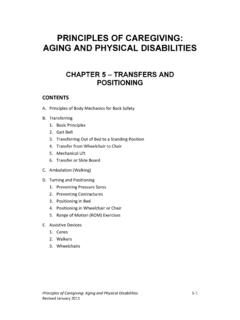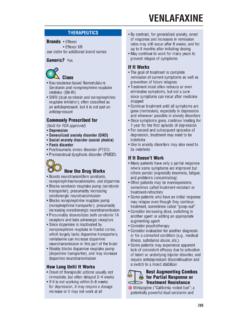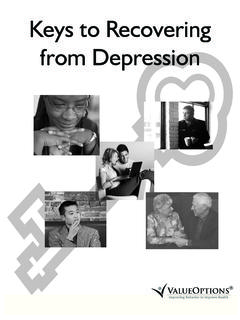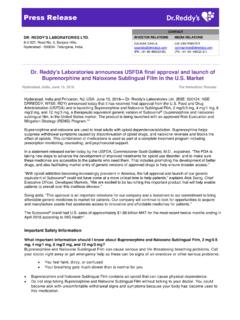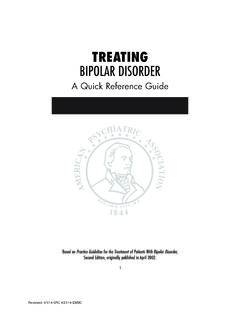Transcription of CHAPTER 3 – PSYCHOLOGICAL/EMOTIONAL …
1 PRINCIPLES OF CAREGIVING: AGING AND PHYSICAL DISABILITIES. CHAPTER 3 PSYCHOLOGICAL/EMOTIONAL . CONDITIONS. CONTENTS. A. emotional Impact of Chronic Disease or Disability B. emotional Impact of Aging C. Anxiety D. Depression E. Addictions and Older Adults F. Resources Principles of Caregiving: Aging and Physical Disabilities 3-1. Revised January 2011. CHAPTER 3 PSYCHOLOGICAL/EMOTIONAL Conditions OBJECTIVES. 1. Identify common psychological and cognitive conditions. 2. Describe behavioral, communication, and safety issues associated with these conditions. 3. Explain effective techniques for addressing these conditions. KEY TERMS. Adjustment Obsessive-compulsive disorder (OCD). Anxiety disorder Panic disorder Comfort zones Phobia Depression psychological Holistic view Suicide Principles of Caregiving: Aging and Physical Disabilities 3-2.
2 Revised January 2011. CHAPTER 3 PSYCHOLOGICAL/EMOTIONAL Conditions A. emotional IMPACT OF CHRONIC DISEASE OR PHYSICAL DISABILITY. So much of the emotional impact of a chronic illness or physical disability revolves around the adjustment. Adjustments to not feeling well, to decreased activity and capability, and changes in priorities, finances, self-image, and relationships can all surface at the same time. Adjustment isn't just for the beginning stages of an illness. There is a continued need for emotional and mental change as the physical changes become more evident. Chronic illness or disability often produces feelings of helplessness, frustration, hopeless- ness, or great sadness. It is common to experience resentment at being ill or needing others' help and grief at loss, at the multiple aspects of loss.
3 Regardless of the illness, there is a powerful emotional component which contributes to a need for physical and emotional support and care. The emotional wellness of an ill and/or aging person has a major and marked impact on the physical symptoms under stress. Exactly how emotions, mind and the physical body relate is, of course, a complex question. Improvement of emotional wellness may help control certain physical symptoms in some types of chronic or serious illnesses. Pre-existing attitudes about illness can also affect adjustment. As thoughts and emotions change, physical symptoms often shift. Even when the physical symptoms remain the same, however, the client's attitude about them can help or hinder their disease process. For example, the individuals might see their illnesses in a new, more accepting light.
4 The less people think their illnesses will impact their lives, the greater their overall quality of life may be, even if their symptoms don't improve. The DCW should remember to address the ! emotional as well as the physical needs of the client in his/her care. Providing holistic care and support There is a definite connection between mind and body one affects the other. Healthcare professionals have an increased interest in a holistic view of the client's emotional , physical and spiritual needs in providing care. Holistic means concerned with the whole system, rather than as separate parts. Holistic medicine is concerned with the body and mind and the influence one has on the other. Clients need to feel that their circumstances and feelings are appreciated and understood by the DCW and health care team without criticism or judgment.
5 If clients feel the attention and service they receive is genuinely caring and tailored to their needs, it is far more likely that they will develop trust and confidence in the caregiver and the agency as a whole. Poor psychological and emotional health damages physical health outcomes. Studies have proven a connection with high emotional stress and coronary artery disease. Depression, Principles of Caregiving: Aging and Physical Disabilities 3-3. Revised January 2011. CHAPTER 3 PSYCHOLOGICAL/EMOTIONAL Conditions stress, anger and negative emotions in general are strongly associated with increased physical problems. It is important for the DCW to have a holistic view of the client, to try to meet the emotional , physical and spiritual needs when providing care.
6 For example, it is not just bathing a client, but also understanding the client may feel embarrassed or ashamed by the task. The DCW must have a caring, non-judgmental approach to meet the physical as well as the emotional needs of the client when providing that bath. B. emotional IMPACT OF AGING. As the body ages, there are a number of changes that occur. How a person manages those changes can affect their entire outlook in their golden years.. People age differently, and they think and feel differently about aging. Even though there are many challenges of aging, these can often be addressed through simple steps that improve communication and make the environment safer and easier for the older person to navigate. The existence of an efficient, effective caregiver may help to make it easier for the older individuals to live independently in their homes for as long as possible.
7 Physical Impact emotional Impact Energy level slows, less active, may Interests in hobbies/events may lessen. gain weight. Fear of death/religious needs increase. Body systems deteriorating. Social engagements may be refused, isolation Sensory loss (hearing and vision) leads to loneliness. decreases safe movement and Physical effects of aging may have high mental communication. impact, may seek out plastic surgery, etc. External changes: skin wrinkles and Vulnerability may affect comfort, anxiety, trust becomes fragile, gray hair. of strangers. Changes in bone mass and strength, Grief over losses; independence, loved ones, falls often result in serious injury. pets, job, etc. may create severe depression. Sensitivity to scents, light changes, Embarrassment and shame at conditions and medication caused by changing (incontinence, dependence, illness seen as body systems.)
8 Weakness, etc.). Principles of Caregiving: Aging and Physical Disabilities 3-4. Revised January 2011. CHAPTER 3 PSYCHOLOGICAL/EMOTIONAL Conditions C. ANXIETY. Anxiety disorders include: Panic disorder. Obsessive-compulsive disorder (OCD). Post traumatic stress disorder (PTSD). Social phobia (or social anxiety disorder). Specific phobias. Generalized anxiety disorder (GAD). Signs and symptoms Each anxiety disorder has different symptoms, but all the symptoms involve excessive, irrational fear and dread. Behavioral issues People with anxiety disorders may not be able to cope with the stresses of everyday life and have difficulty functioning. For example, they may not want to venture outside of their homes, or they may be afraid of germs to the point of having to wash their hands many times a day.
9 Some people with anxiety disorders can become agitated and aggressive if taken out of their comfort zones. This is especially true for a person with dementia who has an anxiety disorder. Communication techniques Along with other communication techniques you need to use a calm, reassuring approach. (for example, I understand you are upset but you will be safe here. ). Listen with concern and understanding. Treatment/management Treatment is aimed at the cause. If the person has a phobia, treatment may be focused on exposing the person to the thing that causes the phobia gradually (desensitization). Counseling may also help the person cope with stressors to reduce anxiety. Medications, including anti-anxiety agents, may also help. However, anti-anxiety medications can be addictive and may have undesirable side effects, especially in the elderly.
10 Medications should only be used under the direction of a healthcare professional.. I couldn't do anything without rituals. They invaded every aspect of my life. Counting really bogged me down. I would wash my hair three times as opposed to once because three was a good luck number and one wasn't. It took me longer to read because I'd count the lines in a paragraph. When I. set my alarm at night, I had to set it to a number that wouldn't add up to a bad' number.. A person with OCD, from Anxiety Disorders, National Institute of Mental Health, 2009.. Principles of Caregiving: Aging and Physical Disabilities 3-5. Revised January 2011. CHAPTER 3 PSYCHOLOGICAL/EMOTIONAL Conditions D. DEPRESSION. Major depression is the leading cause of disability in the and worldwide.





